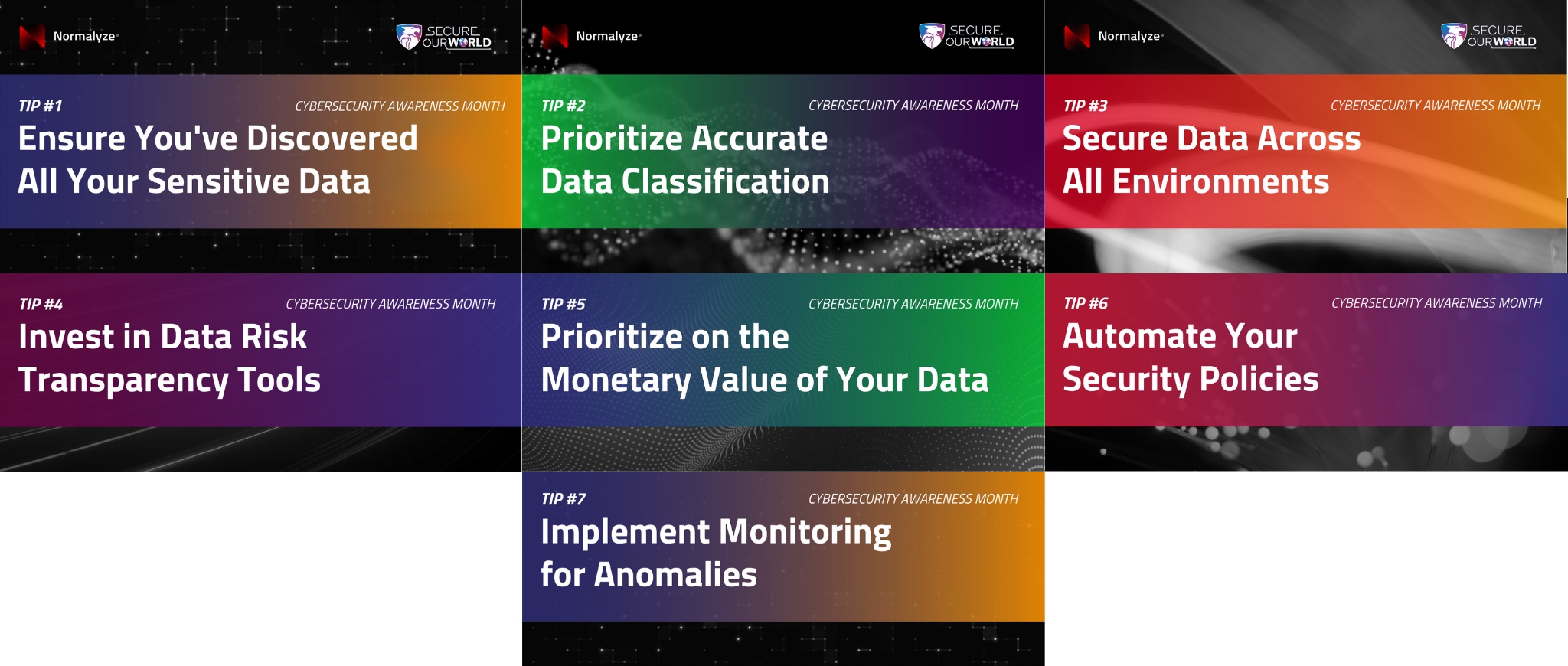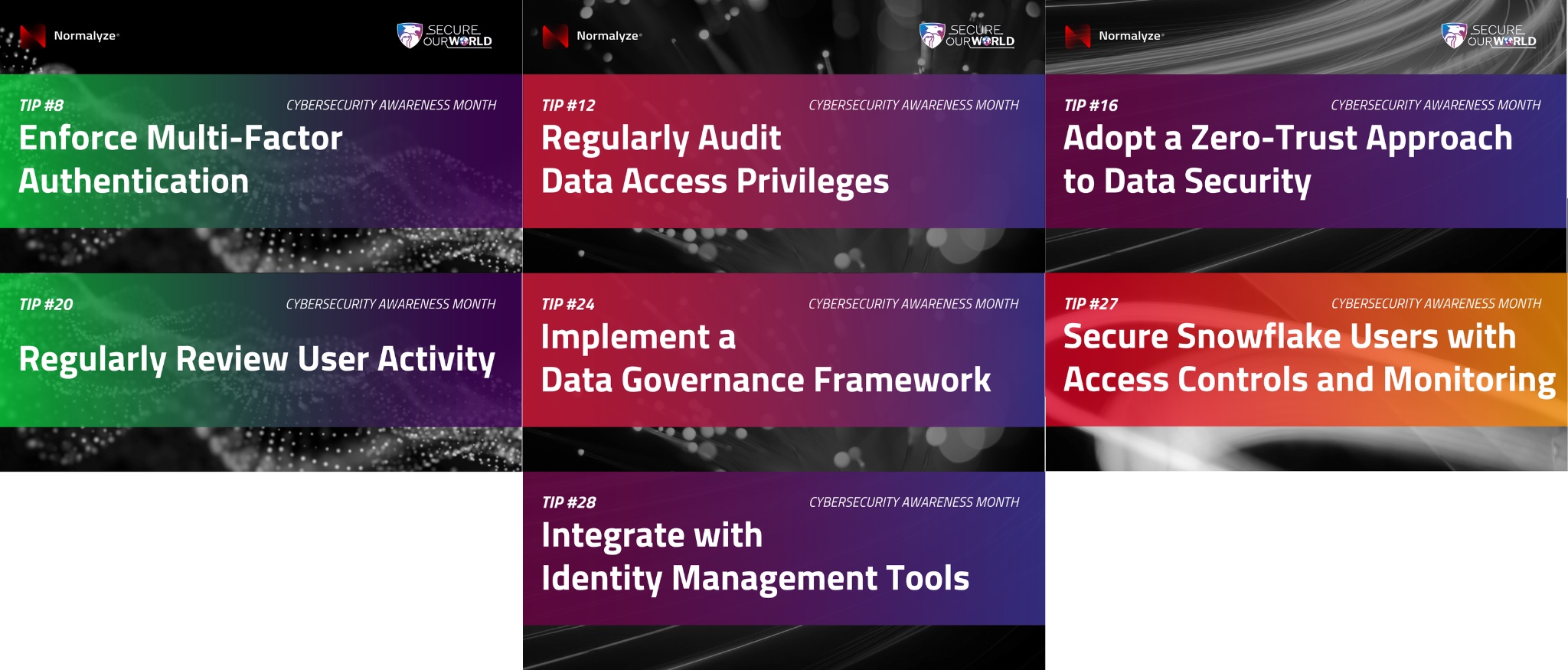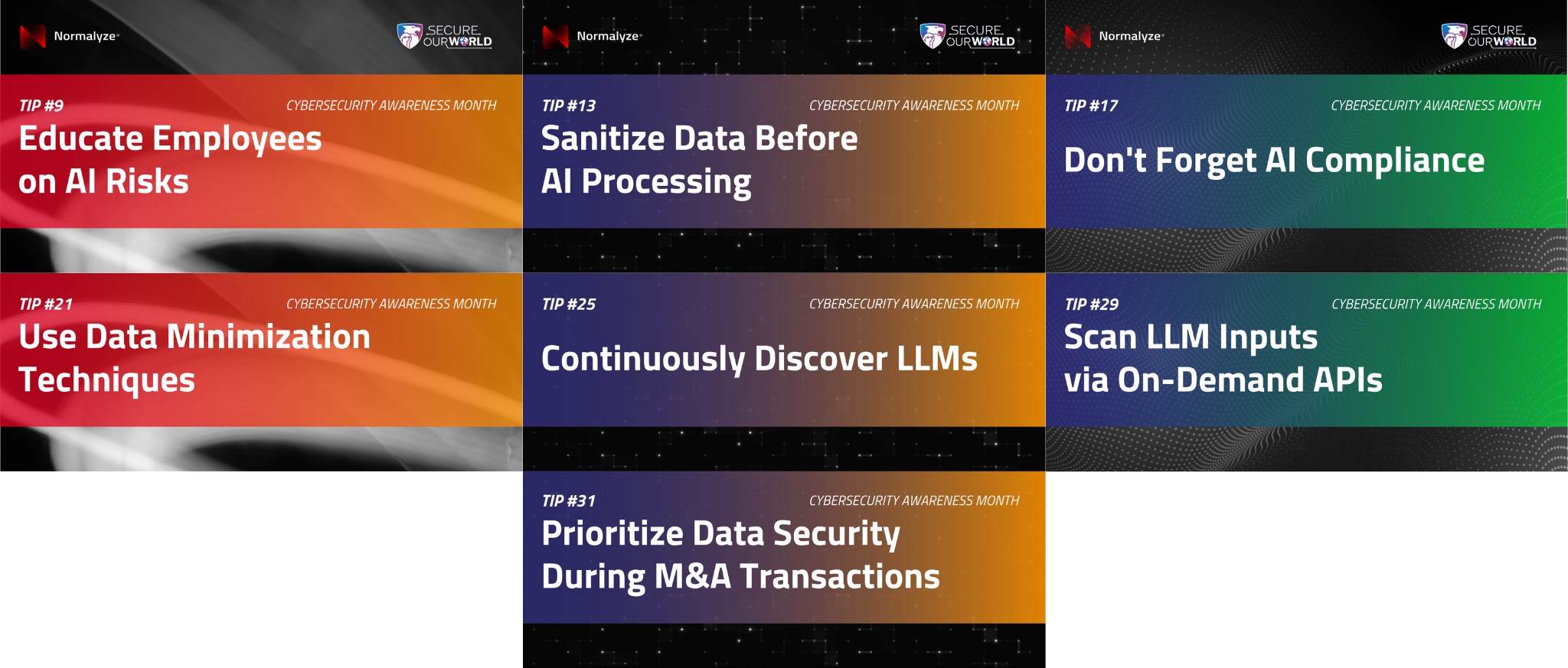Cybersecurity Awareness Month is the perfect time for security teams to take a step back, rethink their data security strategies, and strengthen defenses! In this recap, I’ve gathered 31 practical tips, organized by category, that your team can use year-round to safeguard sensitive data and reduce risks.
I’ve also included links Normalyze customers can use to put these best practices into action, but rest assured, these tips provide a solid approach any organization can follow to protect their valuable and sensitive data
Data Security Posture Management (DSPM)
A strong data security posture starts with understanding your data.
It’s critical to discover all valuable and sensitive data within your organization, especially after major migrations or when dealing with backups that lack a clear lifecycle plan. Once your data is located, accurate data classification becomes key—knowing where your most valuable or sensitive information is stored helps focus security efforts where they matter most. Protecting this data across all environments, whether on-premises, in the cloud, or within SaaS applications, is crucial, and DSPM solutions can help ensure no data goes unsecured.
Additionally, investing in tools that offer real-time risk analysis of your data stores keeps you ahead of potential threats. It’s also wise to prioritize data security based on its monetary value to the organization and to cybercriminals, allowing you to build a blocking / remediation plan that will have the greatest impact.
Automation plays a huge role, especially when it comes to enforcing security policies—by automating data access controls, you can reduce human error and ensure compliance. Lastly, continuous monitoring for anomalies, such as unusual access patterns, can serve as an early warning system, helping you catch suspicious activity before it escalates and ensure compliance with regulatory requirements.
Data Access Governance (DAG)
Data access governance requires a balance between restricting access (including to minimize data breaches, insider threats, and unauthorized access and to support regulatory compliance and privacy requirements) and accurately and efficiently granting it to those who need it (to unlock its full potential and support business needs).
Frameworks like zero-trust help operationalize efficient processes, and implementing a robust data governance framework ensures that data access is tightly controlled while also meeting compliance requirements. Integrating DSPM with identity management tools like Okta can provide a seamless way to control and secure data access at scale across multiple environments.
Another fundamental practice is regularly auditing data access privileges—keeping permissions up to date ensures users only have access to what they need, reducing the chances of insider threats or accidental exposure. Regular activity reviews are also crucial in identifying dormant or unauthorized accounts with access to sensitive data, which can often go unnoticed. For organizations using platforms like Snowflake, immediately applying granular access controls and setting up continuous monitoring for data activity helps protect sensitive information.
Responsible AI Practices
As AI continues to evolve and play a larger role in data management, it’s important to be aware of the risks. Educating employees on the potential dangers associated with AI systems, particularly around securing inputs and outputs, can prevent accidental exposure of sensitive data.
When using AI, it’s essential to sanitize data before processing it to ensure that no confidential information is unintentionally fed into AI models. With the growing prevalence of large language models (LLMs), it’s important to use automated discovery tools to identify where LLMs are deployed, so that they can be properly monitored and secured. On-demand API scanning for LLM inputs can further safeguard sensitive data by ensuring compliance in real time. Minimizing the amount of sensitive data that AI systems process or store also reduces risk.
Compliance is another key consideration—organizations need to ensure that their AI systems align with data protection regulations. By scanning and sanitizing data before it’s used by AI models, you can ensure your organization stays compliant.
Data Storage Costs and Attack Surface Management
Managing the cost of data storage and reducing your attack surface are vital aspects of cybersecurity.
One growing concern is shadow data—data that is created without proper oversight or management, often leading to security risks. Scanning for shadow data and identifying risks posed by unmanaged processes can prevent it from spiraling out of control. Regularly assessing and eliminating abandoned or duplicate data and avoiding data hoarding is another cost-saving practice that also improves security.
Implementing a strong data retention policy is another important step—knowing how long to store different types of data and when to delete it can reduce risks and storage costs. When it comes to cloud storage, reducing costs by removing redundant or abandoned data is a simple yet effective way to optimize security posture.
Lastly, regularly auditing backup systems to ensure that they do not contain sensitive data that could be exposed in case of a breach is essential for comprehensive data protection.
Data Handling
Proper data handling is critical for maintaining security across your organization. Keeping data in its native environment, rather than transferring it externally, helps minimize vulnerabilities and reduces the risk of exposure during the process. In-place scanning tools protect sensitive data by performing scans within the environment where the data resides, preventing unnecessary external access.
Compliance with regional data sovereignty laws is also an important consideration—ensuring that data stays within the correct jurisdiction while maintaining strict access controls is a must for legal and security reasons. When working with third-party vendors, minimizing data transfers reduces the risk of exposure, and it’s vital to ensure that these vendors follow strict security protocols.
Finally, mergers and acquisitions (M&A) can be a vulnerable time for data security. Conducting thorough data discovery and classification during M&A transactions ensures that sensitive assets are identified and protected, while strict access controls and compliance with regulatory standards help prevent potential data breaches.
Focus on Fundamentals
By focusing on these key areas—Data Security Posture Management (DSPM), Data Access Governance (DAG), Safe AI Practices, Data Storage Costs and Attack Surface Management, and Data Handling—your security team can strengthen its defenses and reduce your organization’s overall risk all year.






